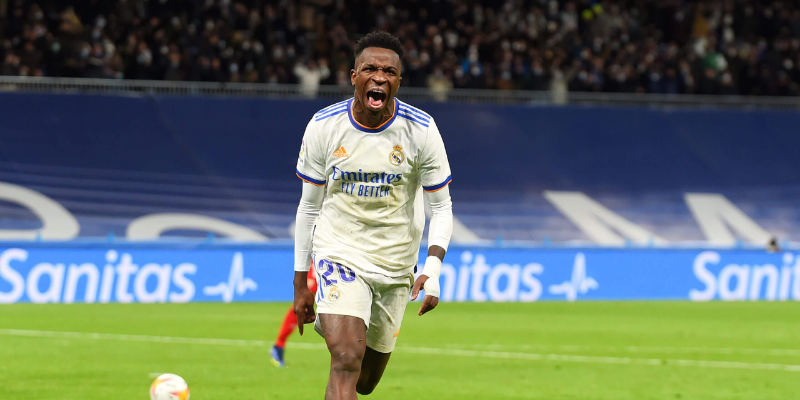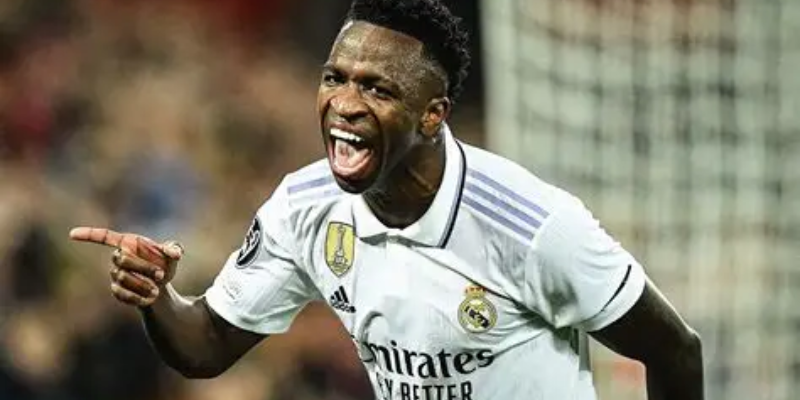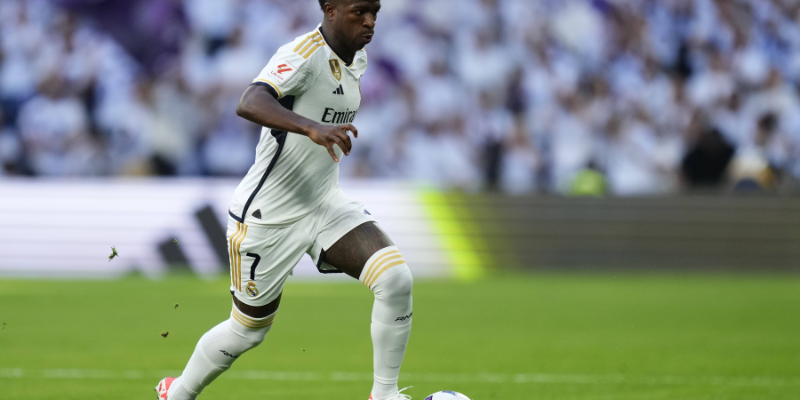Have you ever wondered what is Vinicius Jr top speed? You’re not alone—Real Madrid’s Brazilian winger is famous for turning defenders inside out with his pace., Vini Jr has hit a maximum sprint speed of about 35.97 km/h (roughly 22.35 mph) in a LaLiga match. This is his best-recorded, match-official figure in a top competitive environment. Sources also often round it down slightly, reporting 35–36 km/h depending on measurement method.
In this article, FreeKickSEO will break down where that speed ranks him among football’s fastest, how quickly he accelerates, what the measurements really tell us, and why speed matters so much for his game.
How speed is measured in football
To understand what Vinicius Jr’s top speed means, let’s look briefly at how player speed is tracked.
- GPS & wearable tech during training and matches can record motion, acceleration, and peak velocity.
- Optical tracking systems capture speed data in live competitive fixtures.
- Factors like field conditions, opponent pressure, or tactical context (counter-attacks vs slow buildup) can affect how—and when—a player has opportunity to reach their top velocity.
So when we say Vini Junior has reached ~35.97 km/h, that’s under optimal match conditions: space, high tempo, likely in a sprint situation with minimal disruption.
Vinicius Jr’s top speed in context
Here’s a breakdown of what we know about Vinicius Jr’s speed and how it compares to other elite players:
| Metric | Value for Vinicius Jr | Comparable players & notes |
| Top recorded speed | ~ 35.97 km/h in LaLiga | Very high; among the top sprinters in Spain’s top flight. |
| Common reported range | 35-36 km/h | For many matches, that’s the measure used when “top speed” is cited. |
| Faster speeds claimed? | Some reports suggest 38-38.5 km/h, but these are less substantiated. | These higher numbers often come from non-official (or less consistent) sources. |
| How it ranks in Real Madrid / LaLiga | Among the fastest in the squad & league; only a few players slightly ahead in sheer sprint speed. | For example, Kylian Mbappé is often cited as faster in straight-line sprints; some others reach 36-37 km/h in bursts. |
By that measure, Vini’s speed is world-class. It’s not quite broken some all-time records, but it’s elite.
What contributes to his speed (acceleration, agility, change of direction)

Speed is more than just the flat sprint. Vinicius Jr’s greatest gifts are in how fast he gets going and how well he uses speed inside tight spaces. Here’s what sets him apart:
- Acceleration: He often beats defenders in the first few steps—his 5- to 10-meter bursts are very strong. Even if a player has a higher top speed, Vini often gets to his peak fast.
- Change of direction and agility: Vini’s dribbling style is explosive—not just straight sprinting, but weaving, cutting, feinting. In many match moments, his ability to shift direction while maintaining speed is more dangerous than raw top speed.
- Tactical use: Real Madrid often build plays to exploit his speed either in transitions (defence to attack) or by isolating him on the wing. That gives him the space to unleash his pace.
How Vinicius Jr compares with the fastest in the world
To really grasp how fast ~35.97 km/h is, let’s see where that places him among the fastest footballers globally.
- Many of the top speedsters (e.g. Mbappé, Alphonso Davies, Achraf Hakimi) regularly log top speeds in the 36-37 km/h range or slightly more under ideal conditions.
- Vinicius is slightly behind the absolute max performers, especially those whose role involves sprinting down the wing behind defenses or chasing long balls.
- Still, in LaLiga and the Champions League, Vini is consistently among the top speeders. He’s not just listed in rankings: match action shows how defenders struggle to keep up.
Limitations & caveats of top speed data

While speed figures are exciting, they have some built-in limitations. Here are things to be cautious about:
- Measurement error: Different tracking systems may produce slightly different numbers. Camera angles, sampling frequency, and how the sprint is isolated all impact the reading.
- Context matters: A player may never reach top speed if never given the space; defensive pressure, tacklers, or simply game flow limit chances to sprint.
- Consistency vs peak: A single sprint might show 36 km/h, but what matters often is how often a player can sustain speed, accelerate, and perform at high intensity multiple times in a match.
- Player condition: Fatigue, injuries, and weather/field surface can reduce speed on any given day.
Why his speed matters for Real Madrid and Brazil
Speed like Vinicius Jr’s isn’t just for show—it shapes how games are played and how defenses are broken down.
- It gives Real Madrid options in counter-attacks. A long pass forward, or turnover in midfield: Vini can exploit space before defenders set.
- It forces opposing backs to decide: stay high and risk being outrun, or drop dee.
- For Brazil, the same applies. His speed adds width, directness, and threat in international competitions where moments of space can be rare.
Records, notable sprinting moments & highest reliable measures

Some of Vinicius Jr’s notable recorded speed/sprint stats:
- The 35.97 km/h mark is one of his best in LaLiga.
- Numerous sources list him running ~36 km/h in matches, often rounding his best to that figure.
- Some earlier reports suggested speeds up to 38.5 km/h, but these are less consistent in terms of source reliability or game conditions; many analysts treat ~36 km/h as the solid benchmark.
Conclusion
In sum, what is Vinicius Jr top speed? FreeKickSEO confirms that his best verified top speed in a competitive match is about 35.97 km/h. That places him among the fastest footballers in LaLiga and the Champions League—but just a notch behind some of the very fastest sprinters globally.
Want to dive deeper? We can look at how his acceleration stacks up versus other top wingers, or compare his sprint volumes (how many sprints per match) to see not just how fast he goes, but how often. Let me know which angle you’d like next!






